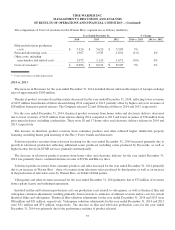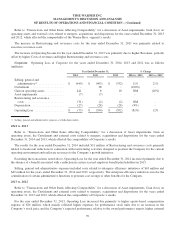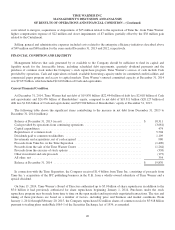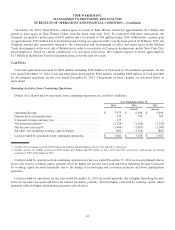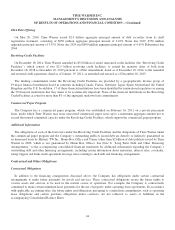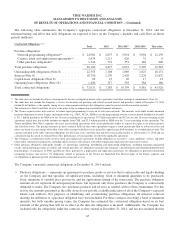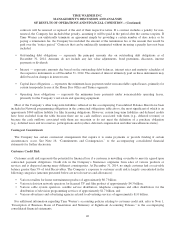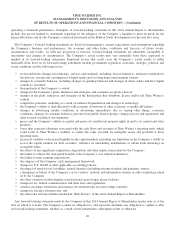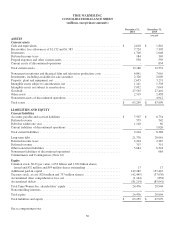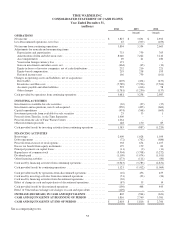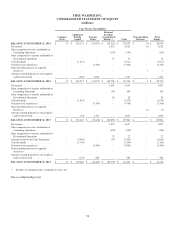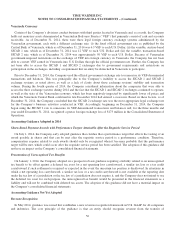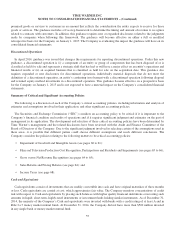Time Magazine 2014 Annual Report Download - page 63
Download and view the complete annual report
Please find page 63 of the 2014 Time Magazine annual report below. You can navigate through the pages in the report by either clicking on the pages listed below, or by using the keyword search tool below to find specific information within the annual report.
TIME WARNER INC.
MANAGEMENT’S DISCUSSION AND ANALYSIS
OF RESULTS OF OPERATIONS AND FINANCIAL CONDITION – (Continued)
MARKET RISK MANAGEMENT
Market risk is the potential gain/loss arising from changes in market rates and prices, such as interest rates, foreign
currency exchange rates and changes in the market value of financial instruments.
Interest Rate Risk
Time Warner has issued fixed-rate debt that at December 31, 2014 and 2013 had an outstanding balance of
$21.920 billion and $19.905 billion, respectively, and an estimated fair value of $26.171 billion and $22.659 billion,
respectively. Based on Time Warner’s fixed-rate debt obligations outstanding at December 31, 2014, a 25 basis point
increase or decrease in the level of interest rates would decrease or increase, respectively, the fair value of the fixed-rate debt
by approximately $580 million. Such potential increases or decreases are based on certain simplifying assumptions, including
a constant level of fixed-rate debt and an immediate, across-the-board increase or decrease in the level of interest rates with
no other subsequent changes for the remainder of the period.
At December 31, 2014 and 2013, the Company had a cash balance of $2.618 billion and $1.816 billion, respectively,
which is primarily invested in short-term variable-rate interest-earning assets. Based on Time Warner’s short-term variable-
rate interest-earning assets outstanding at December 31, 2014, a 25 basis point increase or decrease in the level of interest
rates would have an insignificant impact on pretax income.
Foreign Currency Risk
Time Warner principally uses foreign exchange contracts to hedge the risk related to unremitted or forecasted royalties
and license fees owed to Time Warner domestic companies for the sale or anticipated sale of U.S. copyrighted products
abroad because such amounts may be adversely affected by changes in foreign currency exchange rates. Similarly, the
Company enters into foreign exchange contracts to hedge certain film production costs denominated in foreign currencies as
well as other transactions, assets and liabilities denominated in foreign currencies. As part of its overall strategy to manage
the level of exposure to the risk of foreign currency exchange rate fluctuations, Time Warner hedges a portion of its foreign
currency exposures anticipated over a rolling twelve-month period. The hedging period for royalties and license fees covers
revenues expected to be recognized during the calendar year; however, there is often a lag between the time that revenue is
recognized and the transfer of foreign-denominated cash to U.S. dollars. To hedge this exposure, Time Warner uses foreign
exchange contracts that generally have maturities of three months to eighteen months and provide continuing coverage
throughout the hedging period. At December 31, 2014 and 2013, Time Warner had contracts for the sale and the purchase of
foreign currencies at fixed rates as summarized below by currency (millions):
December 31, 2014 December 31, 2013
Sales Purchases Sales Purchases
British pound ................................. $ 1,115 $ 920 $ 1,013 $ 580
Euro ........................................ 738 466 481 468
Canadian dollar ............................... 651 350 569 332
Australian dollar .............................. 355 211 410 178
Other ....................................... 481 187 591 253
Total ....................................... $ 3,340 $ 2,134 $ 3,064 $ 1,811
Based on the foreign exchange contracts outstanding at December 31, 2014, a 10% devaluation of the U.S. dollar as
compared to the level of foreign exchange rates for currencies under contract at December 31, 2014 would result in a
decrease of approximately $121 million in the value of such contracts. Conversely, a 10% appreciation of the U.S. dollar
would result in an increase of approximately $121 million in the value of such contracts. For a hedge of forecasted royalty or
license fees denominated in a foreign currency, consistent with the nature of the economic hedge provided by such foreign
47


